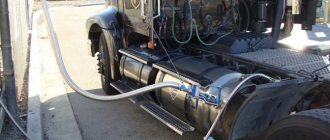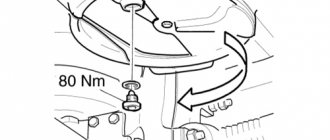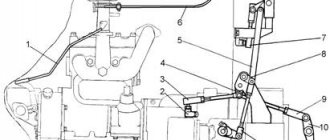The legendary Soviet truck GAZ 53 was produced by the Gorky Automobile Plant for more than 30 years. During this time, more than 4 million trucks rolled off the assembly line. The car has proven itself on the good side - affordable and easy to repair, inexpensive to maintain, the LAWN always came to the rescue when it was necessary to transport cargo. Often the car was loaded more than normal, but it dutifully carried any luggage.
Dump truck based on GAZ 53
Factory and actual fuel consumption standards
According to factory standards, the gasoline consumption of the GAZ 52 12 (and this is the most popular modification) should be 24 liters per 100 km. This indicator is a control measurement; it was obtained at a vehicle speed of 40 km/h on a straight road, without load. In this case, the road should be dry, and the car should move in direct gear and without acceleration.
In reality, everything is completely different. The 53 12 model is equipped with a 4.25 liter carburetor 8-cylinder petrol engine, and with such data fuel economy is difficult to achieve.
This is what a gasoline engine looks like for GAZ 53
Specifications
The platform for the GAZ-53 is a solid frame with a 4*2 wheel arrangement. A lot of different modifications were produced on this basis. At one time, even the KAVZ-685 bus, more familiar as a “boot”. Accordingly, the structure and position of the suspension varied.
The steering does not have any amplifiers, which made driving this car extremely labor-intensive.
The same applies to the braking system; at that time, “assistants” were not yet provided.
There was only one gearbox in service - a 4-speed manual.
Dimensions
- Length – 6395 mm
- Width – 2022 mm
- Height – 2220 mm
- Curb weight – 3200 kg
- Gross weight – 7085 kg
- Base, distance between front and rear axle – 3700 mm
- Trunk volume - n/a
- Fuel tank volume – 90 l
- Tire size – 240/260/280/300/320R508
- Ground clearance – 265 mm
Engine
There was only one engine - a 4.2 liter petrol unit capable of generating 120 hp. More than five modifications were made on its basis, which did not differ significantly.
Gasoline engines
| Type | Volume, cm 3 | Valves | Power, hp (rpm) | Torque, N•m (rpm) | Fuel | Consumption l./100 km.* | Up to 100 km/h, s |
| 1 | 4254 | 32 | 120 hp | 294/4000 | gasoline AI76.92 | 24,5/29/23,4 | n/a |
Dependence of fuel consumption on various factors
A truck cannot constantly move only on a straight, flat asphalt road, and at the same time drive empty. The following factors influence the increase in fuel consumption:
- Machine load level;
- Warming up a cold engine (especially in winter);
- Driving style. Driving with constant sharp acceleration dramatically increases gasoline consumption. Also, do not drive in low gear at high speed or too fast;
- Malfunctions in the carburetor or in the engine itself. Even non-working spark plugs can affect consumption;
- Chassis or brake malfunctions, low tire pressure;
- Road conditions. Going uphill also requires more fuel consumption;
- Poor quality gasoline, clogged air filter.
If you choose a careful driving style - accelerate smoothly, do not exceed speed, then you can slightly reduce your consumption rate. You should also keep your car in good condition.
And yet, in reality, for a GAZ 53 car, the consumption of gasoline is at least 27-30 liters per 100 km, and it is almost impossible to achieve a lower figure.
This is provided that the ZMZ 53 engine or its modifications are installed. What can be done to reduce the consumption rate, or at least reduce the cost of fuel consumption?
Real ways to reduce fuel consumption
To reduce fuel consumption on a GAZ 53 car, car owners use the following methods:
New model body gas 53
- Use smooth driving, without sudden throttle changes and braking, accelerating gradually on the highway;
- Monitor the technical condition of the car, check the tire pressure and, if necessary, inflate the wheels;
- They install gas equipment and use gas instead of gasoline as fuel;
- Replace the standard gasoline engine with an economical diesel engine.
There are several more dubious ways to save fuel:
- Installation of an injection system instead of a carburetor;
- Using a sprayer-gasket under the carburetor;
- Using a magnetic fuel activator.
Technical condition of the car
Driving a car is more or less clear, but the technical condition should be understood in more detail.
Gas 53 modification option with residential kung
- The air filter is clogged. Power disappears, the engine becomes “stupid”. It is very simple to check if the filter is clogged - you need to remove it from the housing and carry out an external inspection;
- The carburetor is clogged. It should be removed, washed and reinstalled. Carburetor adjustment is of great importance - if the quality screws are too loose, gasoline will be consumed significantly more;
- One or more cylinders are not working. There are a lot of reasons for inoperability - from simply faulty spark plugs or broken high-voltage wires to burnt-out cylinder head valves or pistons in the engine.
The ignition order may be confused, for example, the high-voltage wires are incorrectly distributed across the cylinders. Incorrectly set ignition also leads to increased fuel consumption; - The ignition system is faulty. The problem with the GAZ 53 car is the switch. Due to its overheating, the engine stops working normally and traction is lost. Accordingly, fuel consumption increases;
- The brake wheel cylinder is stuck. When the car begins to slow down due to the cylinder, resistance to the movement of the car arises, fuel consumption increases;
- Low tire pressure. The resistance to movement also increases; flat tires need to be pumped up.
Official sources
Gasoline consumption for a GAZ 53 can be found from official sources, where factory measurements are described. According to official data, this figure is 24 liters. But the actual fuel consumption of the GAZ 53 may deviate significantly from the information indicated here, since it may depend on various factors.
24 liters per 100 kilometers are used by this truck in good technical condition, with minimal load and at a speed of 40 km/h
. In reality, this figure may differ and become significantly larger depending on various factors. Official measurements took place under favorable conditions, but in real life such conditions are rare.
The information is given for the basic configuration, which has an 8-cylinder engine with a capacity of 4.25 liters.
during maintenance or repair
A properly functioning power steering is a guarantee of safety and confident truck control in any conditions.
In the modern automotive market you can find a huge number of products for vehicles. At the same time, the assortment includes spare parts, devices and entire systems of both adequate quality and not so good. In principle, this is not surprising, since companies are trying to make more money with less investment in production - this is the whole essence of economics.
Various factors affecting consumption
You cannot expect from a car that the average fuel consumption of a GAZ 53 per 100 will be exactly what is indicated in official documents. A positive change is quite expected, because it is rare when a car has to move on an empty highway, a flat road, optimally loaded, etc.
Such factors affect fuel consumption
:
- machine load level;
- outside temperature (engine warming up);
- driver's driving style;
- mileage;
- air filter;
- technical condition of the engine;
- carburetor condition;
- tire pressure;
- brake condition;
- fuel quality.
Tuning
Today, GAZ trucks are no longer produced, and vehicles of this series, which continue to move on the roads, require modifications and modernization of the design. This is explained by the fact that the car no longer looks the same as it did during the Soviet Union. Therefore, vehicle owners resort to different types of tuning to restore the beauty of the truck and improve its performance.
Engine modernization
The most common tuning option is to improve the engine used in the car. First of all, you will need to completely replace the old motor with a unit that will have most of the following advantages:
- low fuel consumption;
- long service life, allowing the device to be used for up to 400 thousand km;
- ease of maintenance;
- high efficiency.
Installing such a motor will make driving a truck more comfortable and faster. If a decision has been made to change the power unit, then it is necessary to do the following:
- Removing the previous motor.
- Welding fasteners on the frame.
- Replacement of the exhaust system, fuel tank capacity and wiring.
You will also need to remake the driveshaft and change the adapters of the device.
Cabin upgrades
Once the engine is updated, you can begin to improve the interior space. It is worth noting that the original version of the cabin is not particularly sophisticated or comfortable. Inside, everything is made using simple plastic and thick metal. Therefore, drivers decide to make a number of changes to organize comfortable travel.
Possible upgrade options:
- attaching a lampshade from a foreign car;
- installation of central locking;
- alarm installation.
Additionally, they replace seat upholstery, install modern instrument panels and other devices that can make movement in a vehicle convenient.
Proven ways to save
Unfortunately, today gasoline is not as cheap as in the Soviet Union. Prices for this type of fuel, as well as for diesel fuel, are steadily rising every day, making transportation on this GAZ truck more expensive. However, knowledgeable drivers have found more than one way to save on fuel consumption in simple and reliable ways.
- The fuel consumption rate for the GAZ 53 in the city is higher than on the highway and can actually reach up to 35 liters per 100 km. But when driving along busy city streets, the dependence of fuel consumption on driving style increases. If the driver drives the car aggressively, with sudden starts and braking. If you drive more carefully and more smoothly, you can save up to 15% of fuel.
- The linear fuel consumption of the GAZ 53 on the highway is 25 liters
. But these data are given with an empty load. Since this model is a cargo model, it is difficult to imagine how you can save on reducing the weight of the cargo. However, if you don’t “drive” the GAZ with a load when you can do without it, this opportunity is worth taking advantage of. - It is necessary to monitor the condition of the car, its engine, and carburetor. It is very important that before a long-distance raid the technical condition of the transport is checked and all breakdowns are corrected.
- There is a little trick - slightly overinflate the tires to reduce fuel costs per 100 km. It is important not to overdo it here, because there is a risk of damaging the suspension, especially if the car is loaded.
- You can replace the engine with a diesel one or install a gas installation.
Some saving methods raise some doubts, but are also often used by drivers. You can use the tips and verify their effectiveness from your own experience.
- There is an opinion that the carburetor can be replaced with an injection system to save money.
- For the carburetor, you can use a spray gasket.
- A magnetic fuel activator can also be a way to save money.
Cabin and cargo platform
The GAZ-3307 cab is all-metal, two-door, weighing 303 kg. The cabin tail is also metal, with an alligator-type hood. When painting, a catatheous primer was used, and then top enamel of various colors (the most common are blue and khaki), or a two-layer acrylic-based system: base enamel + varnish). For additional anti-corrosion protection, hot-drying plastisol mastic was additionally applied to the bottom of the cabin, wheel arches, and floor sills using a catatheous primer.
The seats in the cabin are separate (unlike the predecessor GAZ-53/52) - separately for the driver and passenger. For ease of entry, the driver's seat is adjustable both in the longitudinal direction and in the backrest angle. Another significant difference from its predecessor is a more efficient cabin heater - liquid, with a radiator included in the engine cooling system.
The standard GAZ-ZZO7 cargo platform was made with metal sides, the rear and both sides were folding, and a wood-metal base. The internal dimensions of this platform are as follows: length - 3.49 m; width – 2.17 m; the height of the sides is 0.51 m. The weight of the standard GAZ-3307 cargo platform is 440 kg. The loading height of the platform is 1.365 m.
Improvement of technical condition and repair
What fuel consumption is on GAZ depends on the state of repair of the GAZ 53 car. If you begin to notice that gasoline is being consumed too actively, this may be an alarming sign indicating that there may be problems under the hood of the car, perhaps even very dangerous ones.
The reason that your GAZ 53 fuel consumption is too high may be the following problems
:
- filter clogging
; one way to save on gasoline consumption is to replace the air filter, but first you can take it out and check if it is clogged; - carburetor condition
; You can try to wash this car device yourself; It is also recommended to tighten the screws if they are loose; - cylinder performance
; one or more cylinders in the GAZ 53 engine may not work, due to which others have more load, and, consequently, fuel consumption increases; - It is also necessary to check whether all cables are correctly connected to the cylinders; if there are problems with the connection, this may cause increased fuel consumption;
- breakdowns in the ignition system
; this part of the machine design may cause the motor to operate with interference due to overheating; as practice shows, the switch is a very common problem on the GAZ 53; - low tire pressure
; Fuel consumption directly depends on this factor; If increased tire pressure can help save money, but vice versa, under-inflated tires will cause unnecessary expenses.
Service
The GAZ 53 engine has a good service life. The motor has a high level of endurance. It ensures a long service life of the vehicle, practically does not undergo frequent breakdowns and does not fail.
To increase the service life of the engine, the engine should be regularly maintained. It includes the following work:
- Regular replacement of engine oil. The optimal indicator for replacement is when the vehicle travels more than 6 thousand km. Experts recommend using a mineral or semi-synthetic type of motor oil. Such fluids are suitable for UAZ and Volga cars.
- Adjusting the position of the block head, tightening the manifold fasteners. The latter is known as a spider. It is recommended to perform the procedure every 1-2 thousand km of vehicle mileage. If during operation the cylinder head gasket was replaced or another element of the system was repaired, the procedure is mandatory. It is worth considering that the tightening should be carried out when the engine has cooled down.
- Check and adjust the fluid level in the cooling system. This procedure can become a daily procedure. It is especially important to do this in the summer, since rising temperatures can cause the engine to overheat. Repairing the engine cooling system is expensive. Therefore, if you do not want to overpay for a mistake, you should take this item responsibly.
- Adjust the position of the valves. The performance of the motor and the amount of compression during operation depend on how the valve is installed. It’s worth noting right away that the gas distribution system is assembled with high quality, so there is no need to adjust the valves every day. Basically, the procedure is recommended to be carried out after replacing the cylinder head gaskets.
- Monitor the level of oil in the internal combustion tank. This mainly concerns owners of Volga and UAZ cars. A similar procedure is carried out to provide elements and mechanisms with the required amount of lubricating fluid during vehicle operation. For monitoring, a level is provided inside the container, which will allow you to determine the lack of oil in time and add it.
- Conduct an external inspection of the vehicle. The fact is that during trips various breakdowns can occur, one of which can lead to oil leakage from the engine. Many argue that this is one of the main engine problems that needs to be solved. If a leak is discovered, it is necessary to take measures to eliminate it as quickly as possible.
Gas installation
A gas engine is a popular way to save on fuel today. Gas costs almost half as much as gasoline or diesel. In addition, the advantage of gas equipment in a car is that consumption remains at the same level.
1The most widely used truck in the Soviet and Russian period was the famous GAZ 53. The dump truck initially rolled off the assembly line in 1961, and production continued for more than thirty years. The last model of the GAZ truck in 53 modifications was released in 1993.
If you count the total number of dump trucks produced, you get a total of about four million. Moreover, during the period of its existence, GAZ was produced in various configurations. This range of modifications made it possible to use the truck in many areas of life. In addition to being used for civilian purposes, the GAZ 53 also served in the military sector. Often the dump truck was used for commercial and other areas.
The main engine of the GAZ 53 for the entire period of its production is an eight-cylinder unit, the volume of which is approximately 4.2 liters. This motor was installed on most dump trucks. The carburetor was used exclusively to supply fuel. The transmission has always been mechanical, with four gears always in the box. GAZ 53 in all trim levels had rear-wheel drive. These technical features allowed the dump truck to increase its power output to one hundred and fifteen horses.
Video review
Subsequently, an improved type of combined two-lamp sidelights appeared on the car. The Gorky Automobile Plant offered various modifications of the model:
- classic GAZ 53 (production lasted only 1.5 years). Version with a 115-horsepower ZMZ-53 engine;
- GAZ 53A - an improved version of the classic model;
- GAZ 53A-016 - military version with an additional fuel tank, new equipment and a pre-heater;
- GAZ 53B-02 – chassis for a dump truck;
- GAZ 53-05 - a truck tractor that was not mass-produced;
- GAZ 53-40 – extended chassis without cab;
- GAZ 53-50 - a model for countries with a tropical climate;
- GAZ 53-12 - a modernized basic variation with a 120-horsepower ZMZ-511 engine and increased load capacity;
- GAZ 53-27 is a version running on compressed natural gas.
The high popularity of the model was ensured by its affordable price, which made it possible to carry out substantial tuning with the remaining funds. Thanks to its reliability and maintainability, the vehicle's service life remained quite long. At the same time, repairs to the vehicle could be carried out in the field, and spare parts for the GAZ 53 were always present in large quantities and were of low cost. With normal maintenance, the truck engine covered 400,000 km before the first overhaul.
GAZ 53 was exported to most countries of the socialist camp: Mongolia, Yugoslavia, Poland, Czechoslovakia, Finland, East Germany and Hungary. However, in the early 90s, the car's history ended. It was replaced by a more advanced model, the GAZ 3307. However, the GAZ 53 can still be found on the roads of Russia and the countries of the former USSR.
Fuel consumption GAZ 53
The high fuel consumption of the GAZ 53 is due to some features. Firstly, this is due to the fact that the model was invented in Soviet times, therefore, like many cars of that period, it could not be economical. Secondly, almost all trucks, to one degree or another, consume a significant amount of fuel.
Gasoline consumption GAZ 53 per 100 km
According to official data, the GAZ 53 gasoline consumption standards were 24 liters per 100 km. This calculation was made for mixed use, when part of the movement occurred along the highway, and part - in an urban environment.
Fuel consumption GAZ 53 diesel
The manufacturer did not provide for the installation of engines that consume diesel fuel on the dump truck. However, some modifications of the truck had engines that ran on gas. At the same time, gas installations made it possible to develop power up to 105 horses. At the same time, according to official data, consumption was 32.5, and in winter – 37.75.
Owner reviews about consumption
Alesey, 28 years old, Omsk
I inherited my half-century GAZ from my grandfather, so I know the car inside and out. In summer it takes about 35 liters per hundred square meters, in winter it can be up to 45. It all depends on the load on the body and driving style.
Vitaly, 56 years old, Kemerovo
I am a professional driver, familiar with GAZ. My car consumes no more than 30 liters, while my comrades consume up to 45 per 100 km. It all depends on the maintenance of the machine - I look after my wet nurse, which is why she eats so little.
Oleg, 32 years old, Podolsk
I worked in a car service center for a long time, then moved into trucking. I chose GAZ 53 because it is the only truck in which you can independently reduce consumption. I changed the engine, adjusted the carburetor, so my GAZ car consumes only 23 liters per 100 km.
Pavel, 19 years old, Kostroma
My father and I organize apartment and office moves. We chose a GAZ 53 for work, but were disappointed in the car. It consumes a lot of fuel - up to 50 liters per hundred square meters.











